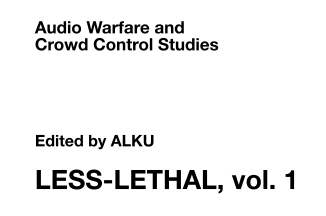ALKU presentará, en formato conferencia + audición, una mirada cáustica al empleo de material sonoro con fines bélicos y no-letales que no deja de ser un ejercicio de reflexión sobre la naturaleza del sonido y nuestra relación con éste (teniendo en cuenta factores como el bagaje cultural, el contexto social o nuestro propio estado psicológico), que pretende ser al mismo tiempo una referencia irónica al mal gusto y la preocupante falta de imaginación que los poderes fácticos y los ejércitos del mundo llevan años demostrando cada vez que deciden hacer uso de la música con fines militares o de control de masas.
ALKU presenta en ZEMOS98 – 9ª edición su cd less-lethal volumen 1. ALKU 63. Various Artists. 5″ Compact Disc. 11 tracks. 16-page booklet. Total program length 51:06
A compilation CD about sound-based nonlethal weaponry featuring tracks by Carlos Giffoni, Dave Phillips, Francisco López, Gæoudjiparl van den Dobbelsteen, Justice Yeldham, Lasse Marhaug, Mark Fell, Powerbooks for Peace, Torturing Nurse, Weasel Walter and Zbigniew Karkowski.
Keywords:less-lethal, nonlethal, torture, warfare, noise, crowd control, psychoacoustics.
LESS-LETHAL, vol. 1 is a sarcastic approach to the use of commercially available music in the military context (see Waco, Noriega, etc.) It includes a 16-page booklet with an essay by German researcher Paul Paulun about nonlethal force and its historical relationship with sound and music.
The foundations for this project were laid around 1999, with a long period of research into the equally blurry and fascinating fields of nonlethal weapons (also known as less-lethal weapons) and the behavioral sciences. Over the course of this time, we found that one of the most interesting aspects of this phenomenon – full of mythology and speculation – was the use of commercially available music in the context of armed conflict, torture and crowd control. Particularly the sheer lack of imagination on the part of military experts who resort to the use of pop music as a weapon, by playing it back for painfully long periods of time at very high volumes.
The direct relationship between sound and behavior has been documented outside the military over the centuries, from the musical treatment of mental patients in the Ottoman Empire to Muzak’s stimulus progression theory. With this in mind, it was the PSYOP’s complete lack of research which provided an excellent starting point for a challenging musical exercise. Eleven artists were invited to contribute a sound piece that could be used as a weapon in an armed conflict.
The resulting tracks approach the subject matter in radically different ways. Amplitude, duration and repetition may indeed constitute key elements of discomfort, but these tracks all go well beyond that. Exploring dynamics and frequency range, structure, latent content, or various aspects from the realm of psychoacoustics, these pieces pose a stimulating (and less lethal) alternative to the average weaponized AOR.


Leave a Reply
Lo siento, debes estar conectado para publicar un comentario.